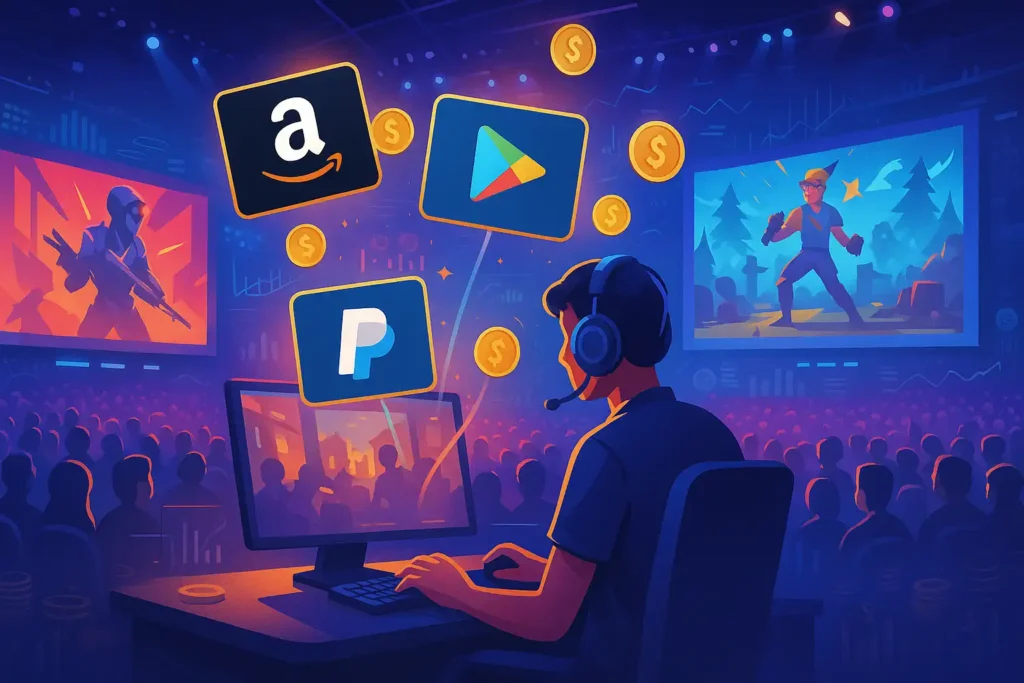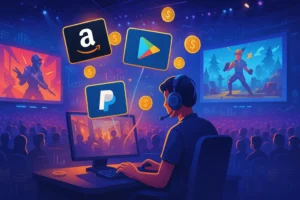
The global gaming industry has grown into a powerhouse worth over $250 billion, with more than 3 billion active players worldwide. But it is not just entertainment anymore. Esports and gaming apps have transformed how people earn, spend, and interact with digital rewards. From major tournament prize pools to mobile apps that give out Amazon, Google Play, or PayPal gift cards, gaming now fuels a new kind of reward economy that blends fun with financial opportunity.
The Growing Power of Esports
Esports has exploded into a mainstream phenomenon. According to Statista, global esports revenue reached $1.8 billion in 2024, with over 600 million viewers expected by 2025. Events like The International (Dota 2) or Fortnite World Cup feature prize pools exceeding $30 million, proving that gaming has become as lucrative as traditional sports.
But beyond professionals, the ecosystem supports streamers, content creators, and everyday players. Platforms like Twitch, YouTube Gaming, and Kick allow creators to monetize streams through ads, sponsorships, and viewer donations. This system has built the foundation for a “play-to-earn” mindset that even mobile gaming apps have adopted. 
Bringing Esports Energy to Everyone
While only a few can compete on global stages, casual players now have access to reward platforms that pay for participation, not perfection. These apps use micro-rewards to make gaming productive.
1. FreeGiftZone
FreeGiftZone offers a hybrid model of entertainment and rewards. You can earn coins for playing arcade games, completing surveys, or watching short ads. Coins can be redeemed for Amazon, Google Play, or PayPal gift cards. The platform also runs a Free redeem code today page where users can grab bonus codes updated daily.
What stands out is transparency. Unlike fake generator sites, FreeGiftZone publishes limited-time codes and verifies every payout, which has helped it build a loyal user base in India and the U.S.
2. Mistplay
Mistplay has become one of the most downloaded reward apps in the United States, with over 35 million users. It lets gamers discover new mobile titles and earn points as they play. These points can be exchanged for Google Play or Amazon gift cards, and the app’s reward catalog updates weekly.
Mistplay has helped developers generate 20–30% higher engagement rates by paying users to explore new games. It is a win-win system that connects developers with active audiences.
3. Buff
Buff focuses on PC and console gamers. Linked with popular titles such as Valorant, Fortnite, and CS:GO, it tracks gameplay through the Overwolf client. Players earn Buff Points for time spent and in-game achievements, which can later be redeemed for Steam, Amazon, or PayPal rewards.
According to Buff’s 2024 report, users collectively played over 500 million matches and redeemed more than 2 million gift cards last year. It is one of the most data-driven reward systems in gaming.
4. Gamezop
Gamezop is another global platform where users can instantly play web-based mini-games without downloading apps. With partnerships across 1,200+ websites and apps, Gamezop shares ad revenue with players through coins that can be converted into digital gift cards or mobile wallet credits.
It is especially popular among mobile-first markets like India and Indonesia, where micro-rewards have become part of daily entertainment.
The Broader Shift in the Reward Economy
The success of these apps proves one thing: people love rewards they can actually use. In 2024, survey data showed that over 68% of users prefer gift cards over direct cash when redeeming small digital earnings. They are fast, global, and secure.
Brands have caught on. Esports teams now partner with fintech and gift card networks to offer incentives. For instance, Visa sponsors Team Liquid, while Amazon Prime Gaming gives away free in-game loot every month. This crossover between finance and gaming signals that reward-driven ecosystems are here to stay.
How Rewards Influence User Behavior
Studies show that gamified rewards increase user retention by 40% to 60%. The reason is simple: earning something tangible creates a sense of achievement. When apps offer Google Play or Amazon gift cards for consistent engagement, users return more frequently and spend more time exploring.
Developers benefit too. Games that include reward loops see 25% higher daily active users and better ad engagement. It is proof that rewarding time, not just skill, drives participation.
Why Gift Cards Lead the Market
Gift cards dominate because they are practical. They work across countries, are easy to distribute digitally, and remove the complexities of bank transfers. A $10 Google Play code can unlock subscriptions, premium games, or apps instantly, while PayPal credits let players spend earnings anywhere.
That universal flexibility is why reward apps, including FreeGiftZone, rely on them as their main payout option. They are safe, simple, and build trust.
What the Future Looks Like
As gaming continues to merge with financial technology, new systems like blockchain and AI-based rewards will make payouts instant and personalized. Some games already use smart contracts to automate gift card delivery after reaching milestones.
Esports teams are also experimenting with fan tokens that act as reward currencies. In the future, you may see players redeem tournament participation points directly for real-world items or cards.
Final Thoughts
Esports and gaming apps have blurred the line between entertainment and earning. What was once limited to elite tournaments has now reached mobile users everywhere. Apps like FreeGiftZone, Mistplay, Buff, and Gamezop prove that gaming can be both engaging and rewarding.
Whether it’s a $5 Google Play credit or a $50 Amazon gift card, these platforms show that the future of gaming is built around value. Every click, match, and minute counts—not just for fun, but for real digital rewards that matter.
